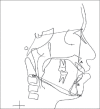Comparison between Growth Patterns and Pharyngeal Widths in Different Skeletal Malocclusions in South Indian Population
- PMID: 29911059
- PMCID: PMC5985678
- DOI: 10.4103/jispcd.JISPCD_77_18
Comparison between Growth Patterns and Pharyngeal Widths in Different Skeletal Malocclusions in South Indian Population
Abstract
Aim: The main aim is to determine whether growth pattern had an effect on the upper airway by comparing different craniofacial patterns with pharyngeal widths and its importance during the clinical examination.
Methodology: Sixty lateral cephalograms of patients aged between 16 and 24 years with no pharyngeal pathology or nasal obstruction were selected for the study. These were divided into skeletal Class I (n = 30) and skeletal Class II (n = 30) using ANB angle subdivided into normodivergent, hyperdivergent, and hypodivergent facial patterns based on SN-GoGn angle. McNamara's airway analysis was used to determine the upper- and lower-airway dimensions. One-way ANOVA was used to do the intergroup comparisons and the Tukey's test as the secondary statistical analysis.
Results: Statistically significant difference exists between the upper-airway dimensions in both the skeletal malocclusions with hyperdivergent growth patterns when compared to other growth patterns.
Conclusion: In both the skeletal malocclusions, vertical growers showed a significant decrease in the airway size than the horizontal and normal growers. There is no statistical significance between the lower airway and craniofacial growth pattern.
Keywords: Lower pharyngeal width; McNamara analysis; upper pharyngeal width.
Conflict of interest statement
There are no conflicts of interest.
Figures
References
-
- Iqbal N, Rasool G, Alam T, Hussain U, Shah SS. Comparison of different craniofacial patterns with pharyngeal widths. JKCD. 2015;6:20–4.
-
- Aboudara C, Nielsen I, Huang JC, Maki K, Miller AJ, Hatcher D, et al. Comparison of airway space with conventional lateral headfilms and 3-dimensional reconstruction from cone-beam computed tomography. Am J Orthod Dentofacial Orthop. 2009;135:468–79. - PubMed
LinkOut - more resources
Full Text Sources
Other Literature Sources



